FORBIDDEN LOVE
How Almyra II was the yacht of one couple's dreams

They were told to forget her – but the couple who came to own Almyra II had already fallen for her, so they bought her anyway. Risa Merl learns how a sensitive refit turned this 50-metre Perini Navi into a stylish family yacht
IYC
If patience is a virtue, it’s one that the owners of Almyra II possess in excess. The 50-metre Perini Navi sailing yacht recently emerged from a speedy refit, but the idea for the project had been years in the making. Ilia Rigas and her husband, whose previous boat was a 25-metre motor sailer named Almyra, first caught wind of the Perini Navi in 2019. Despite the yacht being advertised for sale, they were dissuaded from purchasing her. “We were advised to ‘forget this boat’,” says Rigas. “We were told it was going to be an extremely complicated sale – the owner was suing the bank; the yacht was repossessed – [and] we’d be better off forgetting her completely and finding something else.”
The search continued for a yacht to take them safely around the world on a planned circumnavigation, but this particular Perini Navi, with her sturdy steel hull, easy-to-handle sail plan and ideal layout, stayed in the back of Rigas’s mind. Then, during the height of the Covid-19 pandemic, she discovered the yacht was still for sale, now listed on an online auction. “We got down to two bidders,” says Rigas. With a click of the mouse, they finally secured the yacht. As luck would have it, the other bidder’s internet connection had failed at the pivotal moment. After the sale, he contacted the Rigases and offered to buy the boat from them, but they said no. They had waited long enough for their dream boat. Now there was just the pesky little matter of the refit.
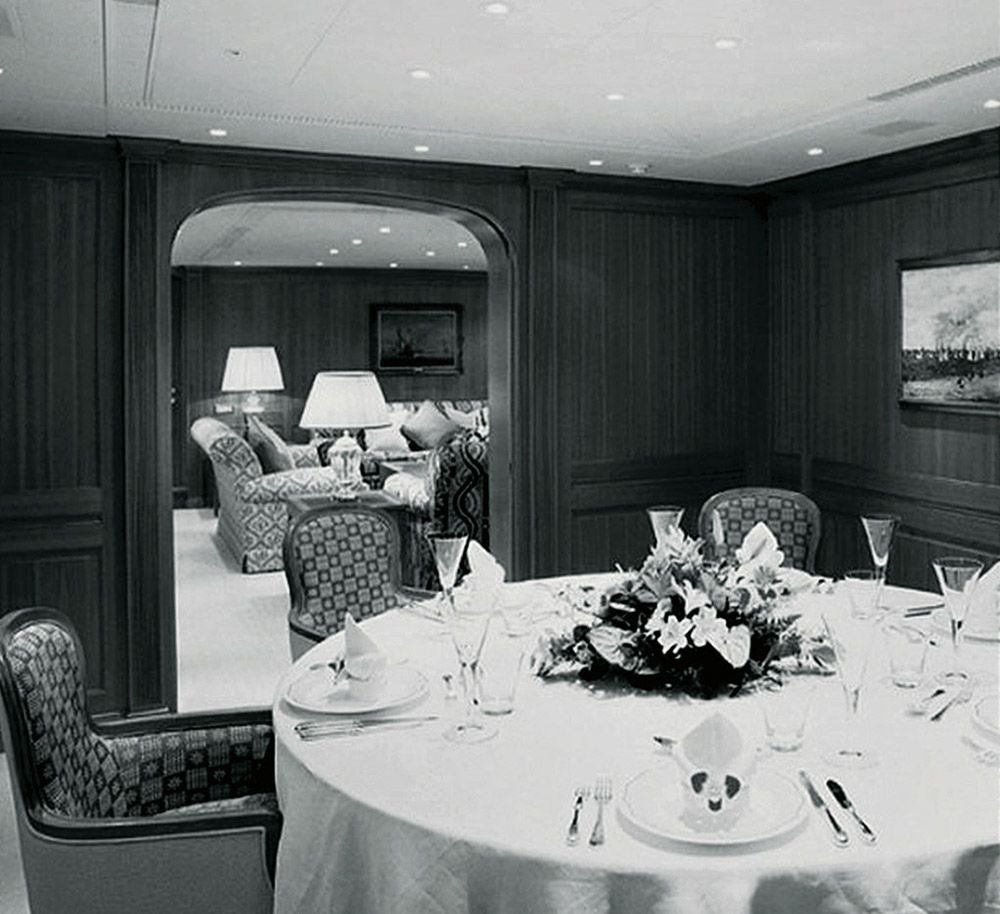
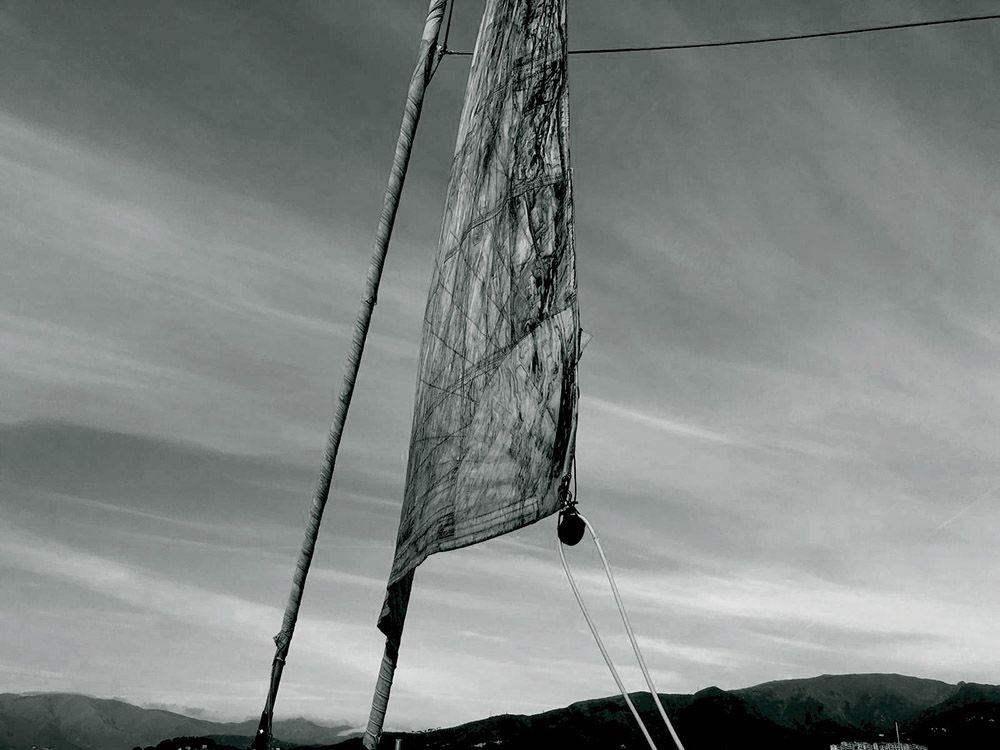
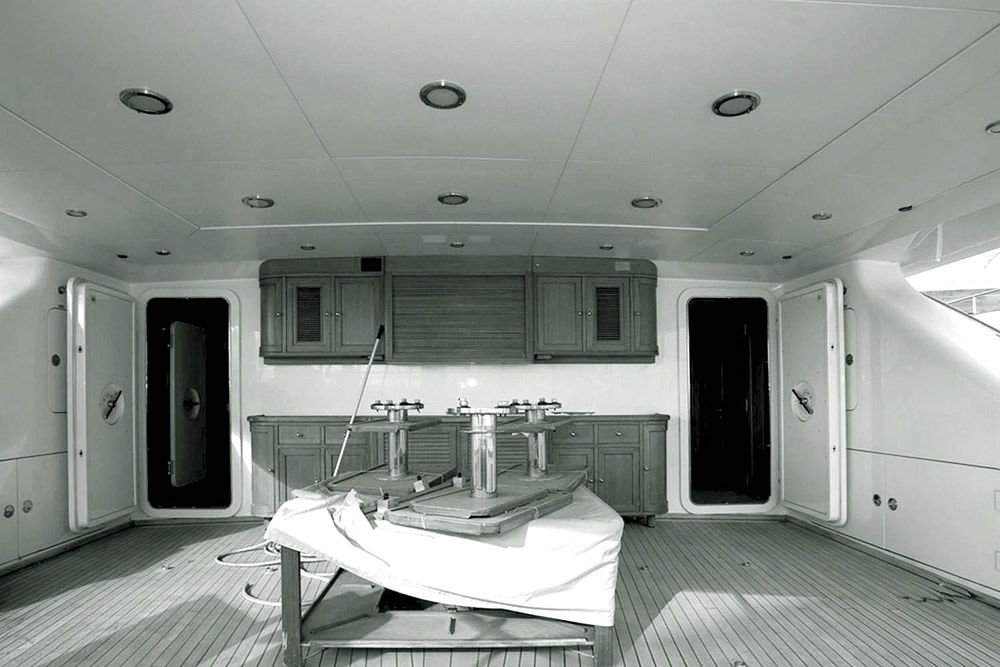
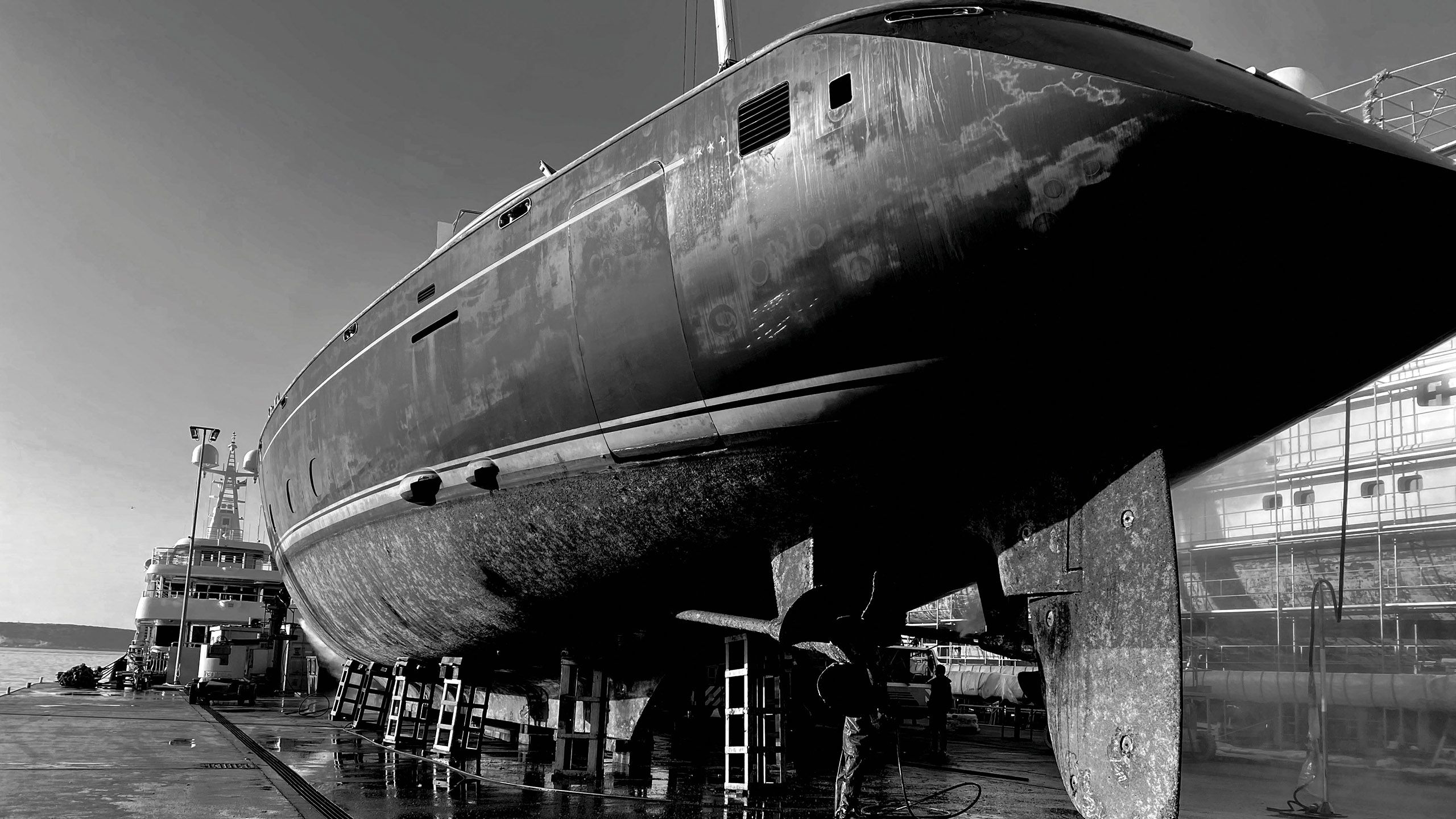

IYC
IYC

IYC
IYC

IYC
IYC

IYC
IYC
Top: The Rigas's bought Almyra II knowing that the boat needed a full and extensive refit. Bottom: It took three coats of Awlgrip to bring the hull back to life
“The energy and flow of this yacht was everything we wanted,” says Rigas. “She had a wonderful open feeling on the aft deck, and inside, the main saloon and dining room could be connected, or a door could slide closed for privacy. We didn’t make any changes to the layout in the end. You have to hand it to Perini – they got that right the first time.”
The layout may have been preserved, but the changes that had to be made during the refit were numerous, mainly owing to the fact that after an Italian bank had repossessed the yacht from its previous owner, she’d had minimal care. “The boat had stayed idle with limited maintenance for four years so naturally there was rust everywhere,” says Rigas. The telltale signs of rust oxidation were easy to see through the paint on the hull. But the Rigases weren’t fazed by the work that would be required.
“When you buy at auction... you can’t do a sea trial or a proper survey of the hull. It was like a blind date, where we got married after one date”
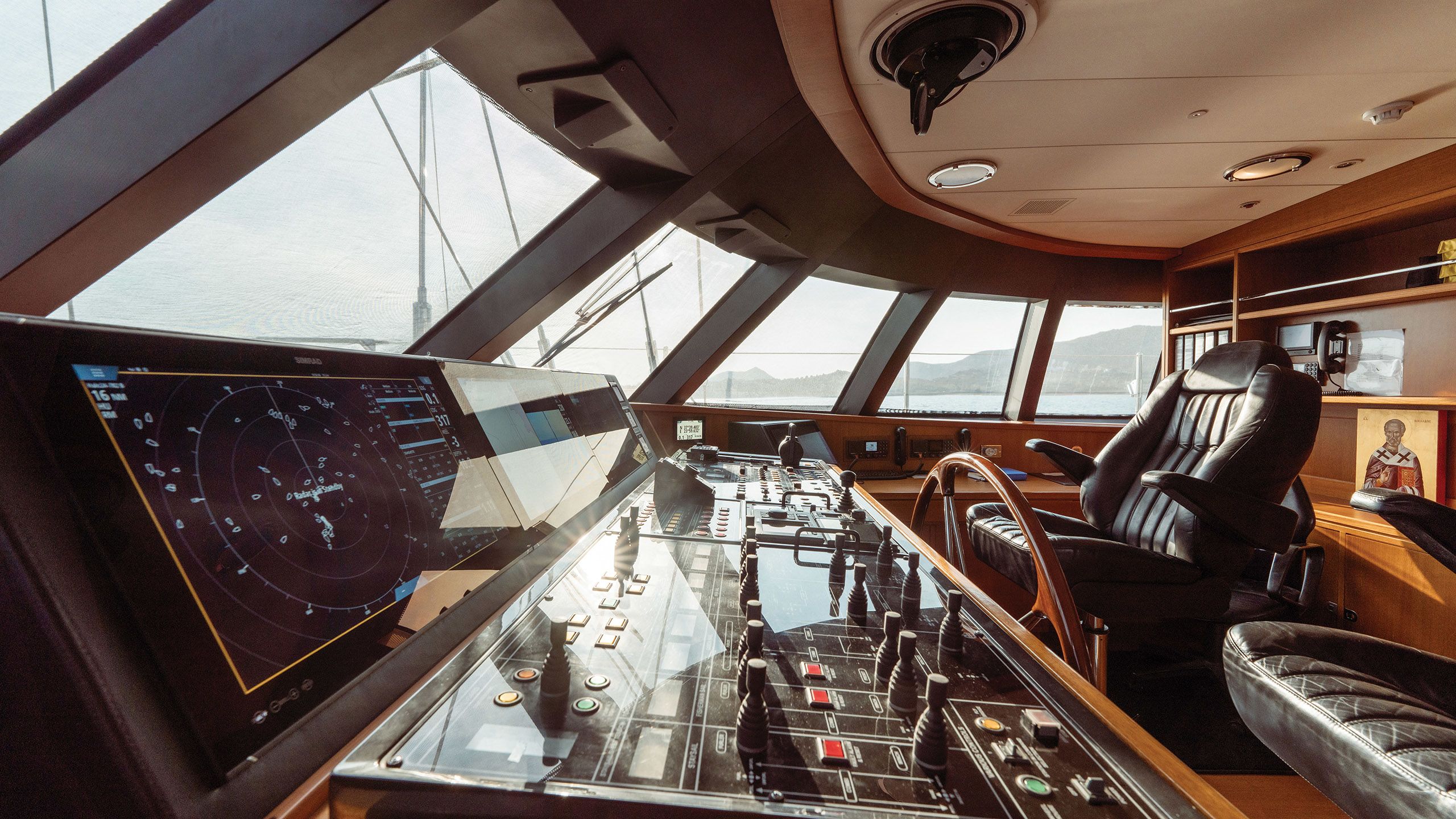
“We bought her knowing that the boat needed a full and extensive refit to meet our requirements for safety, top-end sailing capabilities, luxury living and minimal environmental footprint,” says Rigas. “When you buy at auction, you can see the boat, but you can’t do a sea trial or a proper survey of the hull in a shipyard. It was like a blind date, where we got married after one date – but the design and quality of the original build was so high that we had a great foundation to work with.”
Originally launched in 2000 as Felicità West (then later renamed Ariane), Almyra II is the second of four in Perini Navi’s series of 50-metre, steel-hulled sailing yachts. Rigas had a vision to restore the iconic Perini Navi to a state-of-the-art condition that would enable her to be ready for a future round-the-world voyage. Perini Navi courted the Rigases for the refit project, but the owners opted for a closer-to-home Greek shipyard. “I’m glad we did because, a month later, Perini filed for bankruptcy,” says Rigas of the builder’s insolvency, which precipitated the yard being bought by The Italian Sea Group.
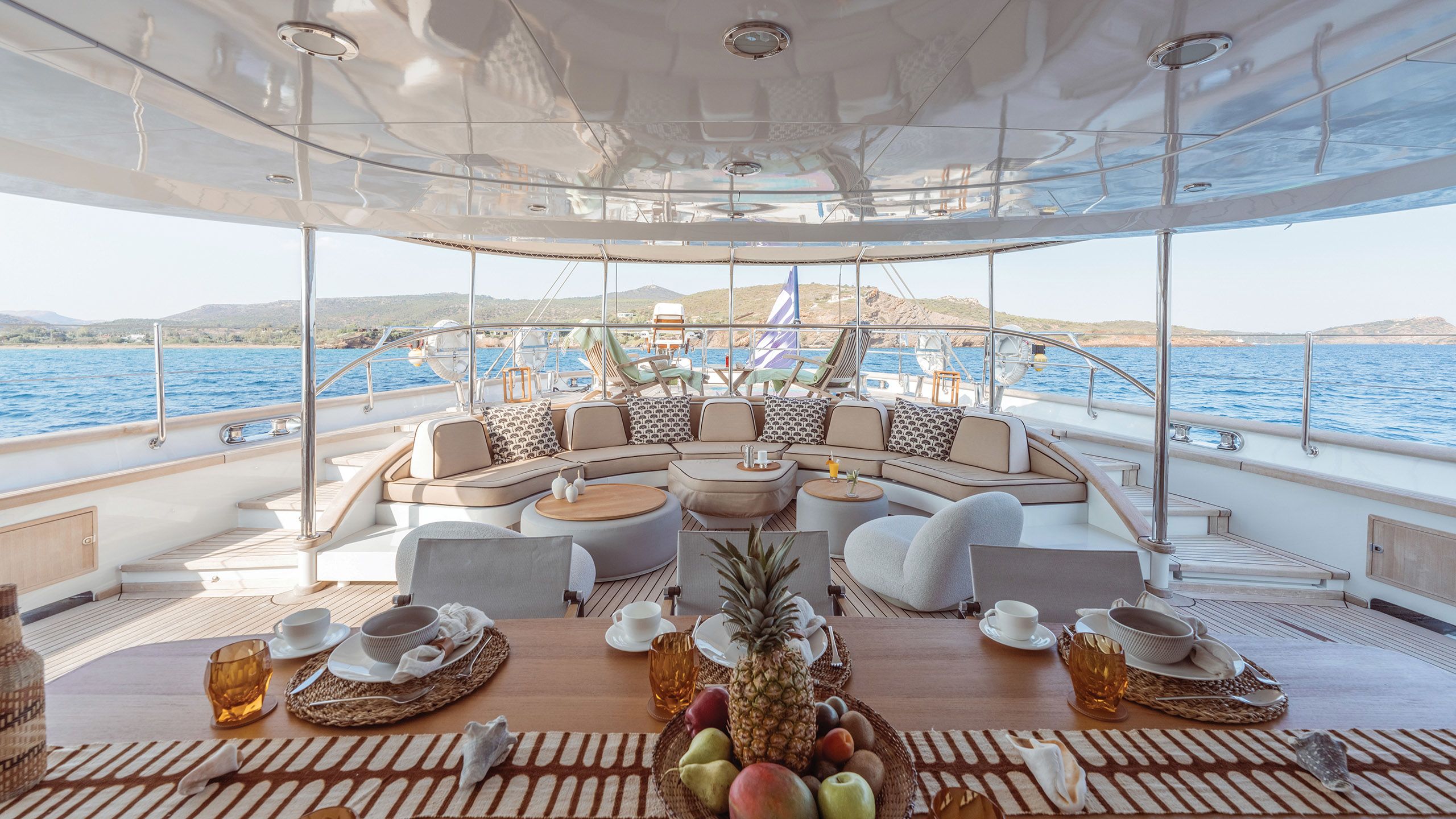

IYC
IYC
A complete revamp of the main deck cockpit included a new sofa, chairs that swivel and a custom-designed dining table
The Spanopoulos Group’s New Hellenic Shipyards is one of the largest yards in Greece and the only one that had deep enough access to accommodate the yacht’s keel. The yacht was in good hands there, says Nikolas Katsoulis, head of the yachting division at New Hellenic Shipyards. “The shipyard has already had significant experience with this type of yacht due to the fact that 95 per cent of Perini Navi yachts owned by Greek owners belong to clients of the shipyard,” he says.
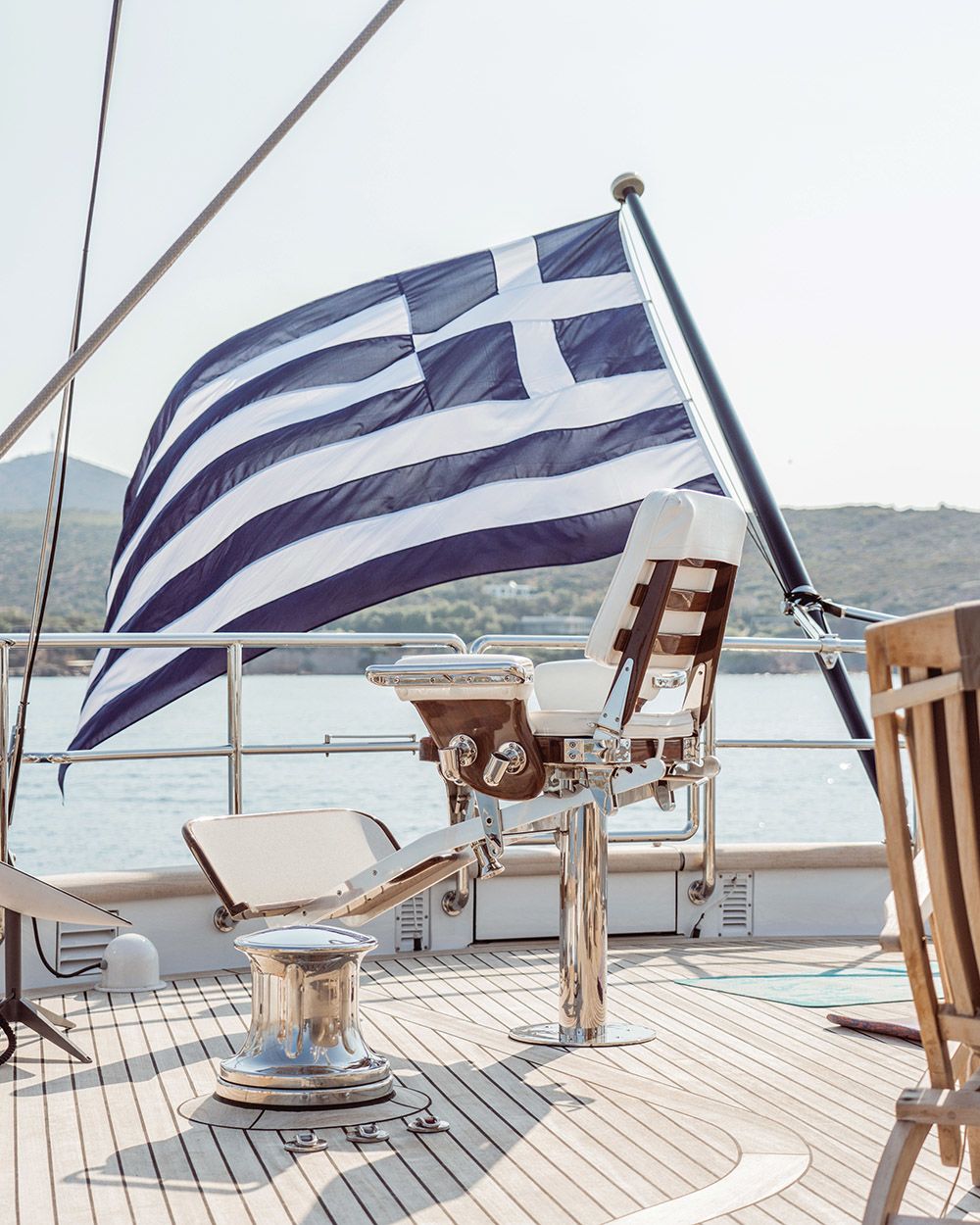
IYCA fighting chair was a must-have for the owners. When not used for reeling in a catch, the chair is a favourite spot for gazing at the horizon while under way
IYCA fighting chair was a must-have for the owners. When not used for reeling in a catch, the chair is a favourite spot for gazing at the horizon while under way
Though the Spanopoulos Group carried out the work, Rigas and her husband served as the project managers, helming a team of subcontractors, including technical workers brought in from Italy. Taking on such a gargantuan task could be a burden for owners, but Rigas says it made the project all the more enjoyable: “We fell in love with the boat even more – it brought us closer to her and to the crew. And we care more than any owner’s rep ever could.”
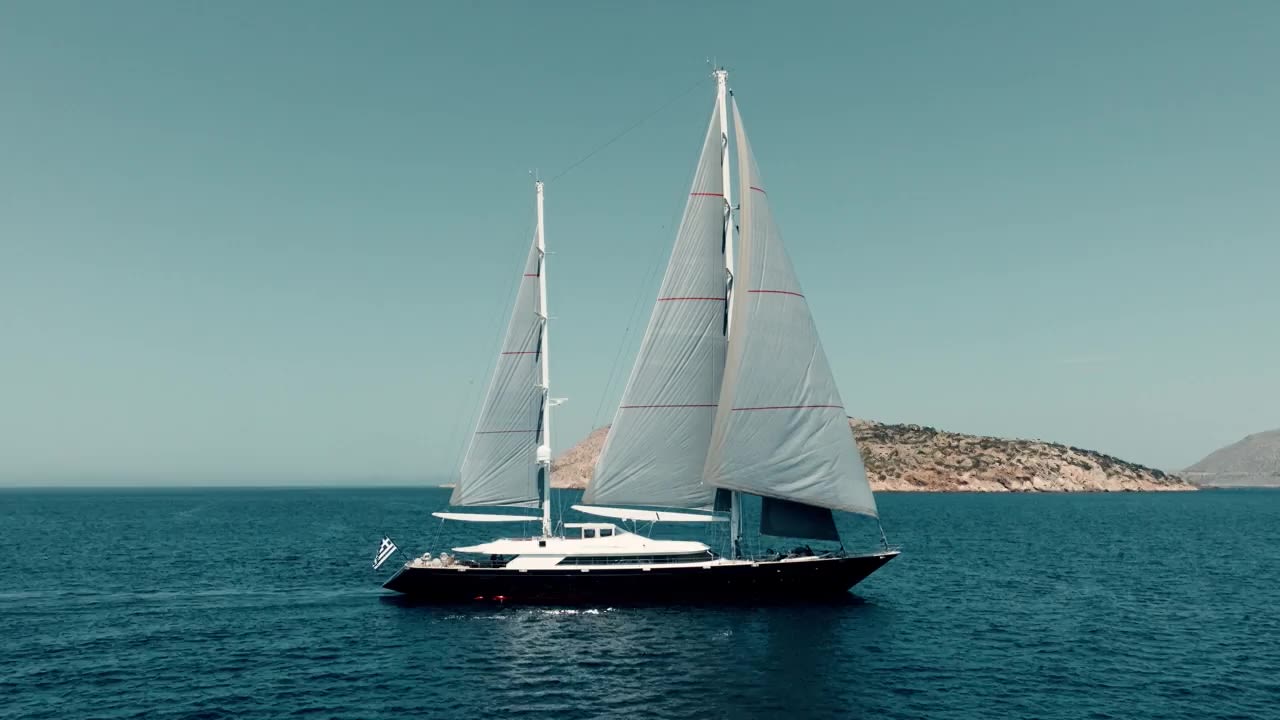
With a background in real estate, Rigas has been a part of project management team before. This, along with 30-plus years of yacht ownership experience and having done refits in the past, gave her the confidence to manage the project. “It was a big challenge,” she says. “But our biggest challenge was to do an extensive refit without the support of the original builder or any access to drawings that were locked up in the closed offices of Perini and not available to us.
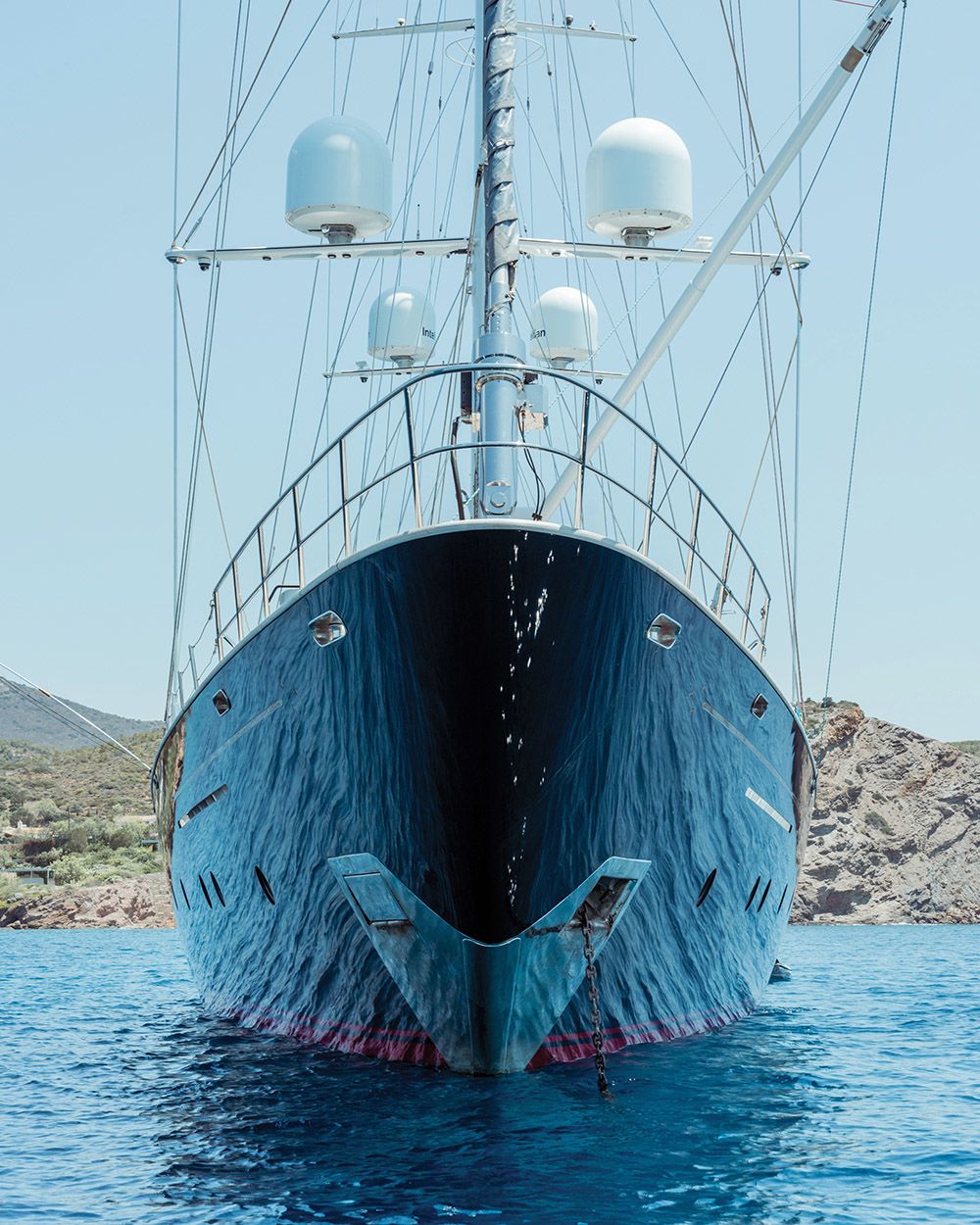
IYCThe refit gave the 22-year-old yacht a new glass bridge with the latest navigation and communication technology
IYCThe refit gave the 22-year-old yacht a new glass bridge with the latest navigation and communication technology
“However, we got support from old employees of Perini that wanted to see this boat come to life, specialist Italian riggers as well as other Perini owners that gave us access to drawings of similar boats. This, combined with our experience, determination and the support of Greek subcontractors, made the dream come true.”
With a background in real estate, Rigas has been a part of project management team before. This, along with 30-plus years of yacht ownership experience and having done refits in the past, gave her the confidence to manage the project. “It was a big challenge,” she says. “But our biggest challenge was to do an extensive refit without the support of the original builder or any access to drawings that were locked up in the closed offices of Perini and not available to us. However, we got support from old employees of Perini that wanted to see this boat come to life, specialist Italian riggers as well as other Perini owners that gave us access to drawings of similar boats. This, combined with our experience, determination and the support of Greek subcontractors, made the dream come true.”
The first job was to disassemble and transport the yacht’s two masts, which was followed by dismantling all the doors, gangways, side doors, hatches and fittings. Then, the yard could start to uncover what other tasks were hidden beneath the neglected hull. “The period that the yacht wasn’t in use was a challenging factor,” says Katsoulis. “You have to keep in mind that, in a project like this, something new is always coming up.”
Indeed, the rust wasn’t just skin deep but had run rampant internally as well. Most of the tasks executed on board were structural and mechanical, including new steel work, piping, electrics and hydraulic works, and the air conditioning was updated as well. All of the monitoring and control systems were fully upgraded and modernised, and the lighting systems were upgraded to improve efficiency.
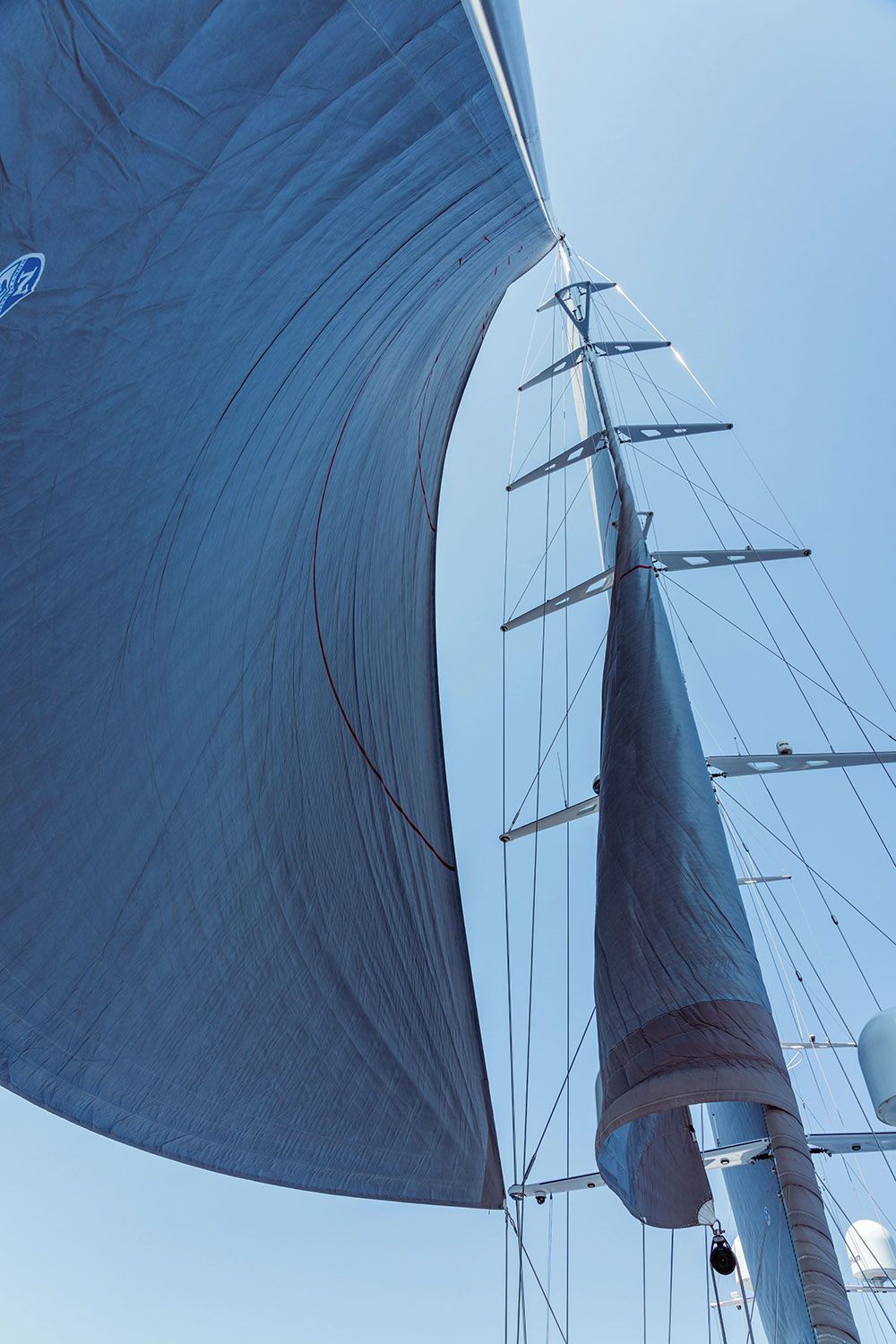
IYCThe first job was to disassemble and transport the yacht’s two masts
IYCThe first job was to disassemble and transport the yacht’s two masts
The sailing equipment was also overhauled and recertified, and a new set of sails from North Sails was chosen to maximise sailing performance. The winches, capstans and all the technical areas on board were updated as well. “One challenge of building in Greece is there isn’t as much experience in sailing superyachts as there is in motor yachts, so we had to bring in the right people to help with the rigging,” says Rigas.
She attempted to hire a Greek designer to work on the interior decor but couldn’t find what she was looking for. Some had worked with big superyachts, but motor yachts rather than sailing yachts, and were proposing ideas that Rigas found far too bling for her tastes. “In the end, I did everything on the interior myself,” she says. “I tried to keep the classy Perini style but make it new.”
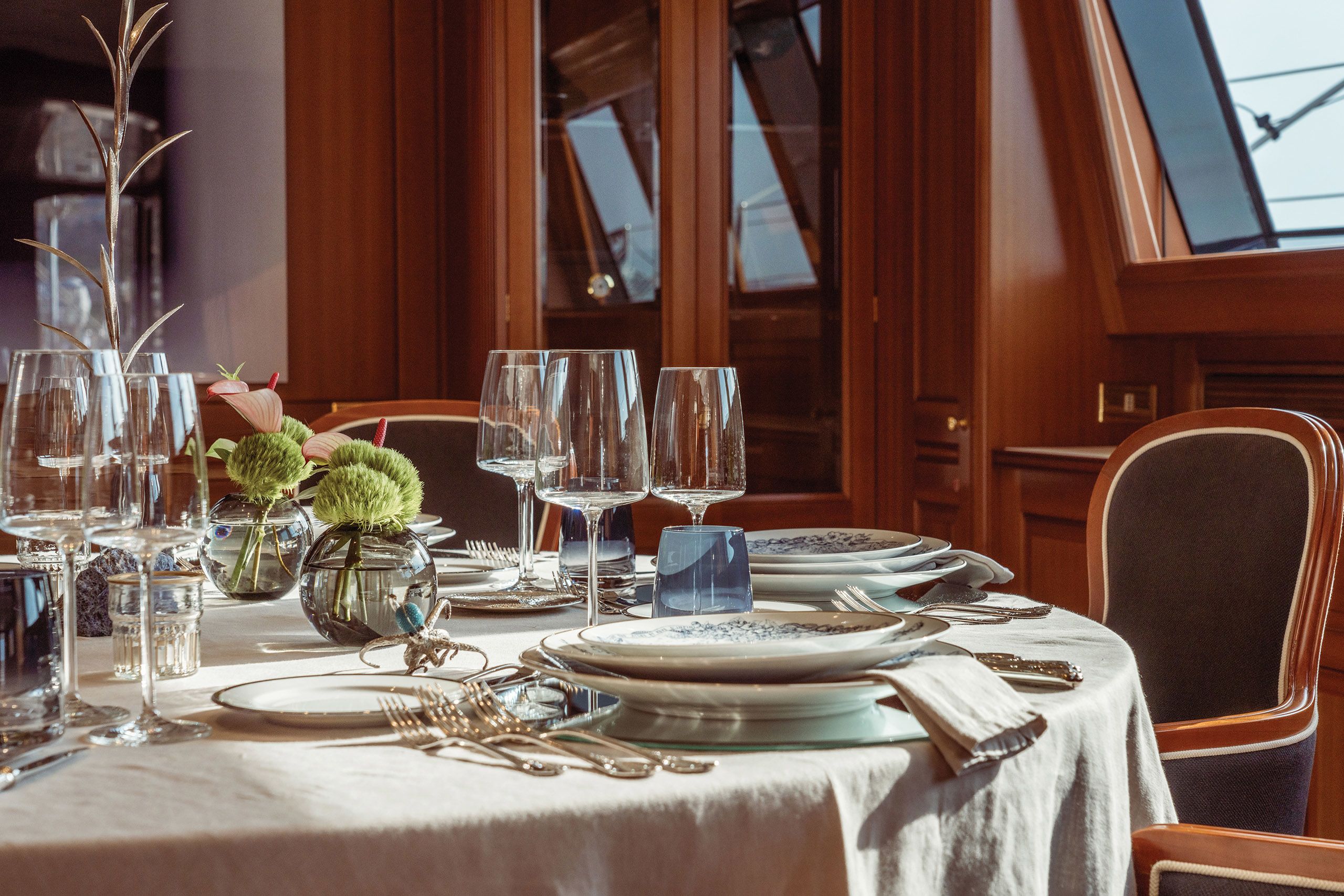
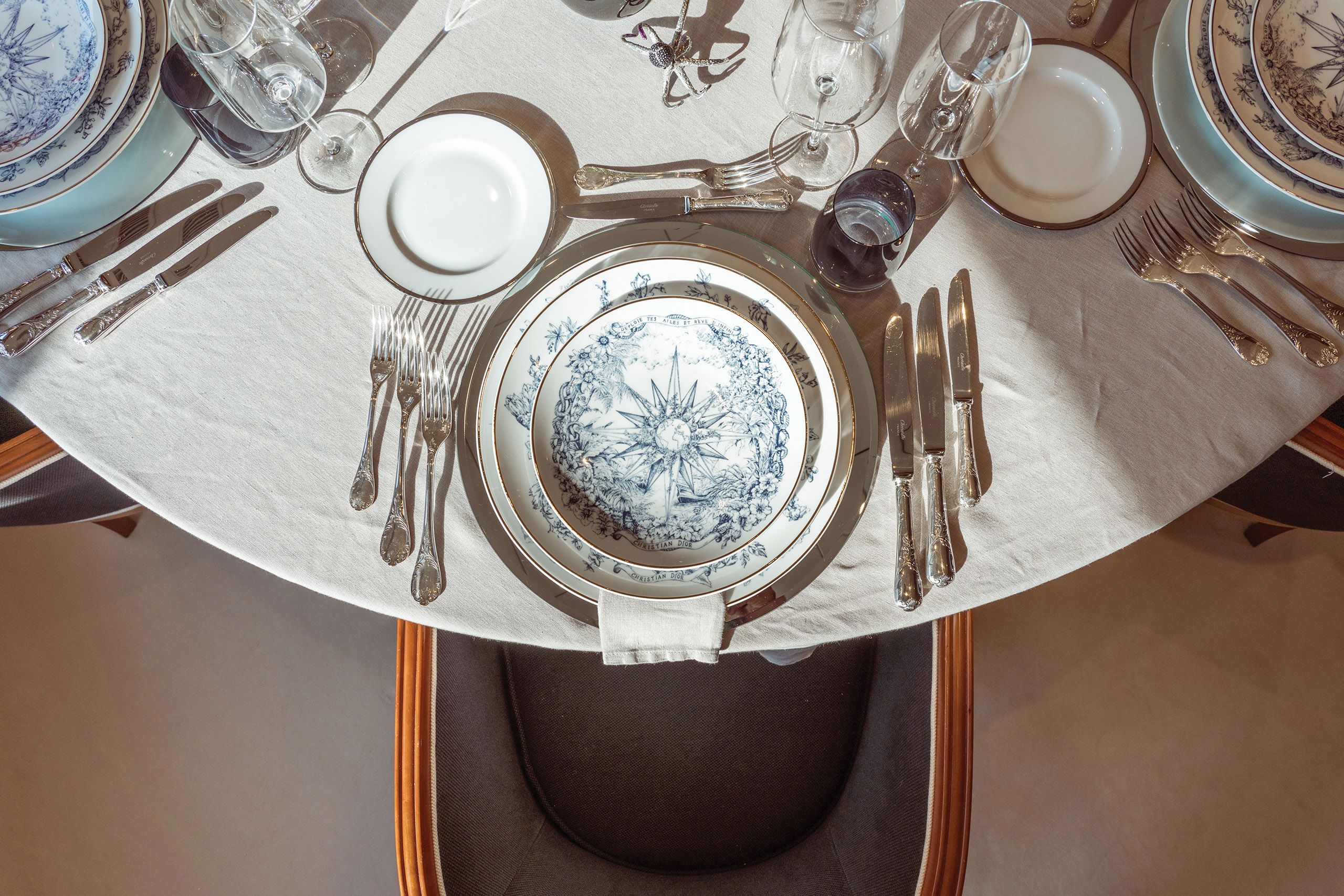
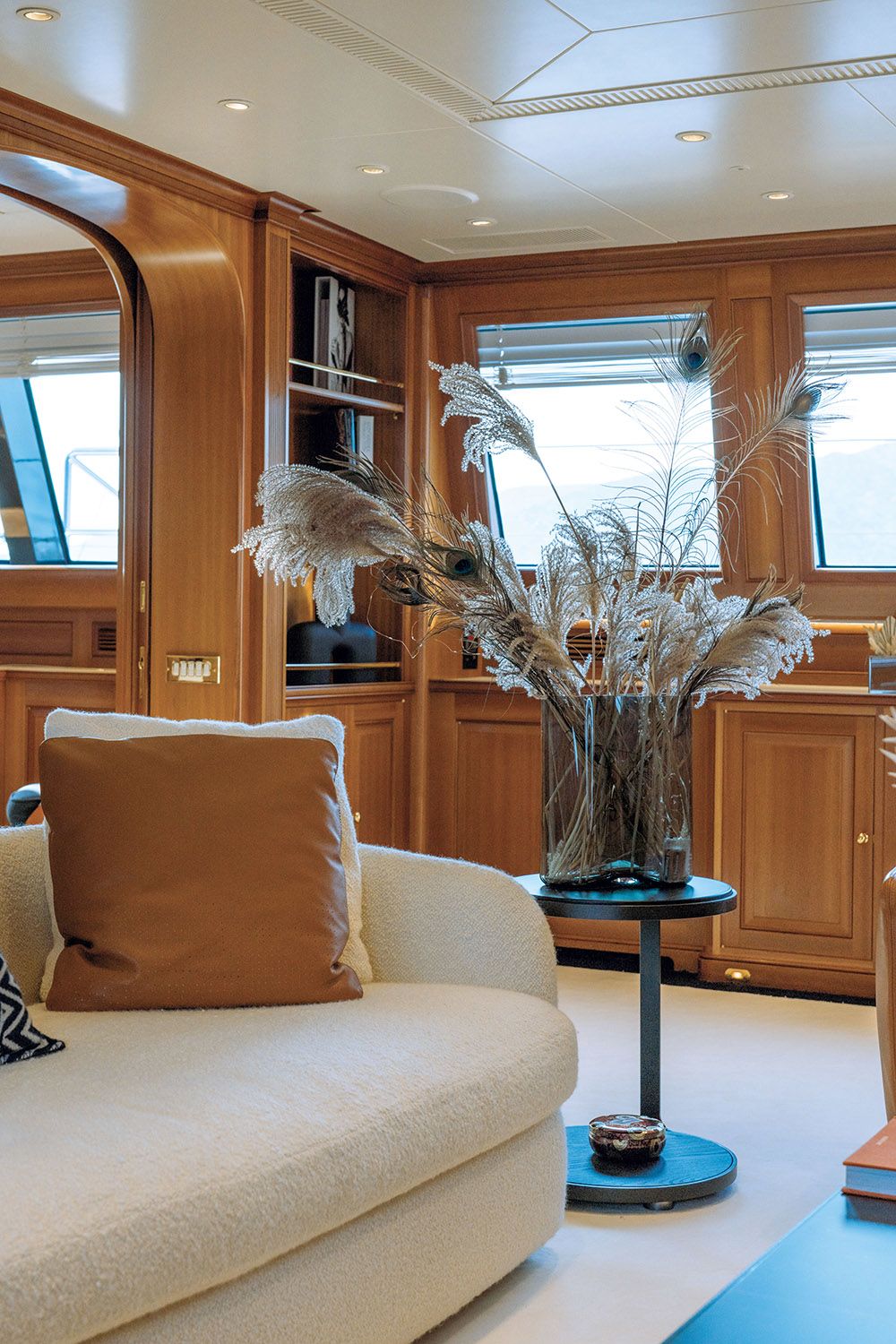
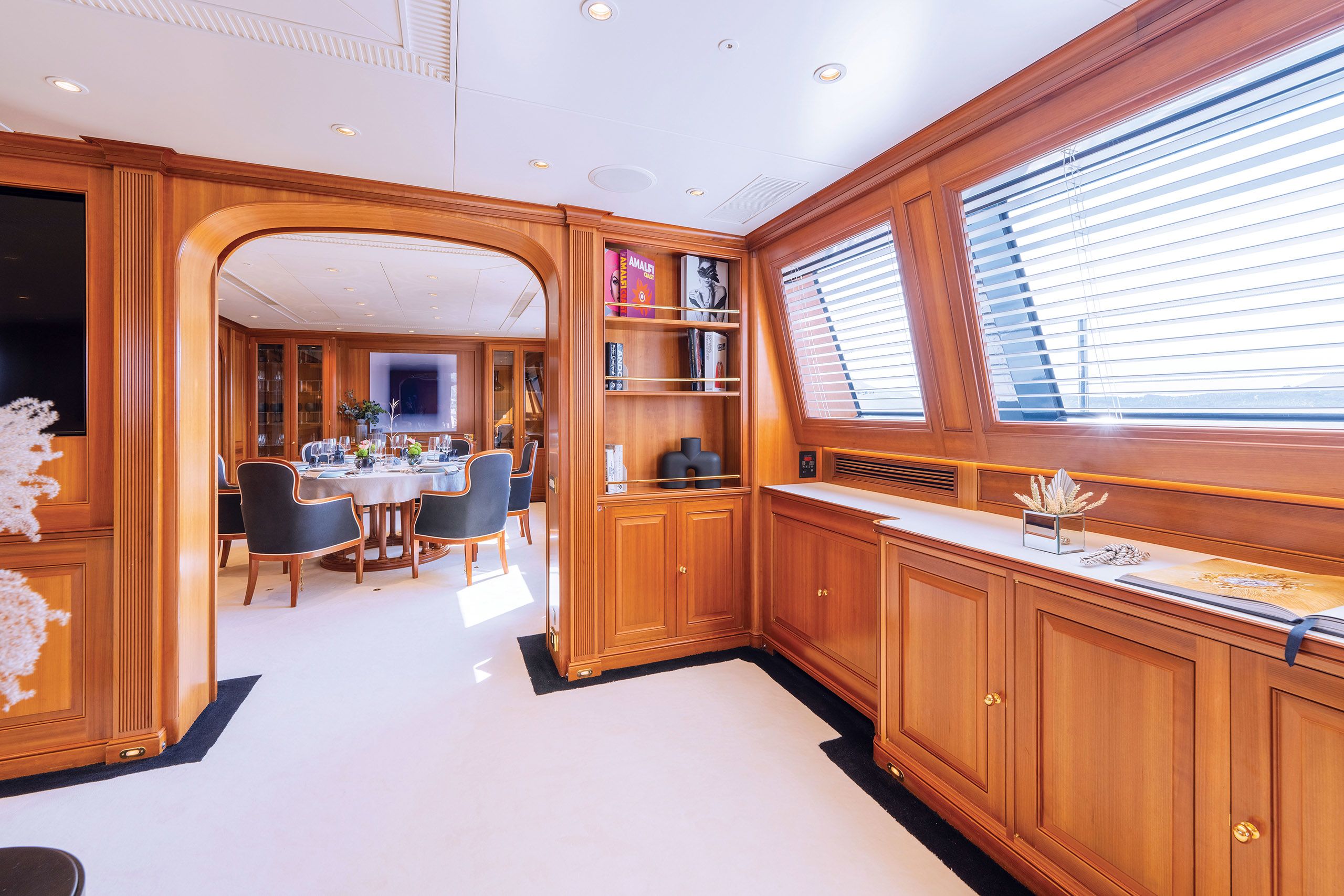
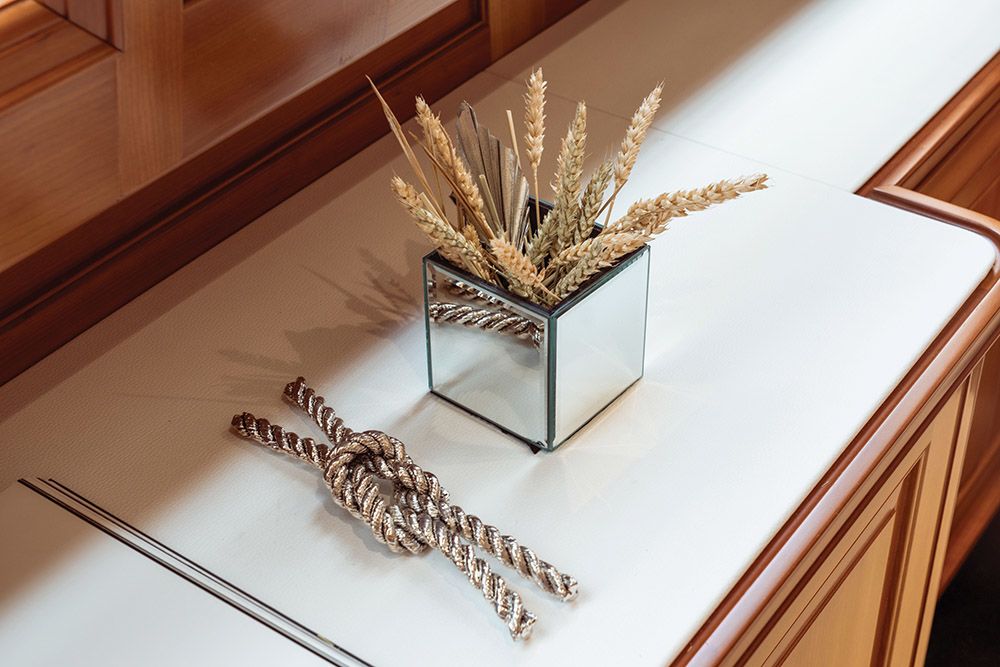

IYC
IYC

IYC
IYC

IYC
IYC

IYC
IYC

IYC
IYC
The owners’ inspiration for the interiors was Hermès meets Ralph Lauren. Top right, limited edition Christian Dior plates complement the nautical feel of the dining saloon
Rigas lives between Athens, Milan and London, and she spent a lot of time in Milan to find items for the interiors. In a sense, the interior refit was more akin to a restoration, preserving the classic nautical style, teak woodwork and gold fittings, but bringing in new pieces to modernise it all. “I didn’t want to interfere with what Perini had done before, but wanted to introduce a fresh styling, and I did this by bringing in art and furnishings and revising the layout of the furniture,” says Rigas. “I have art videos that play on every screen you can see – that was part of [artist Danae Stratou’s] museum project.”
“We didn’t make any changes to the layout in the end. Perini got that right first time”
The original woodwork was repaired, with any scratches fixed, and varnished to a good-as-new gleam. More than 3,000 goldplated handles and drawer pulls, which were damaged in the salty air during the yacht’s years of disuse, had to be removed and refinished. The carpets were all replaced, but the original style was replicated with a white carpet and black frame. “I just thought it was so classy and nice,” says Rigas. Fortunately, the marble in the bathrooms was all in good condition and, apart from new carpets and soft goods, the guest cabins were kept the same as well. The master cabin has an office with its own entrance that can be converted to a fifth guest cabin.
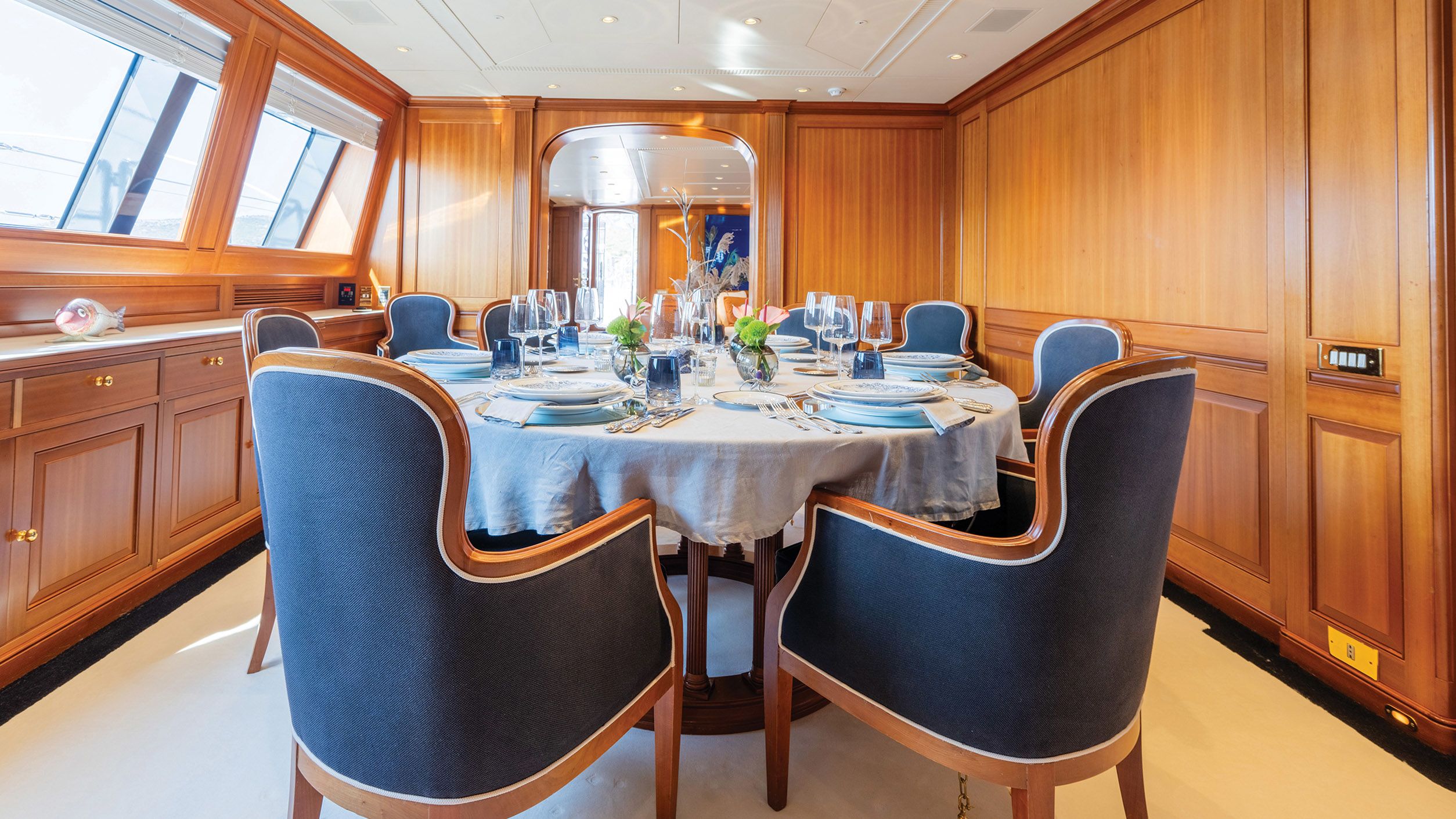
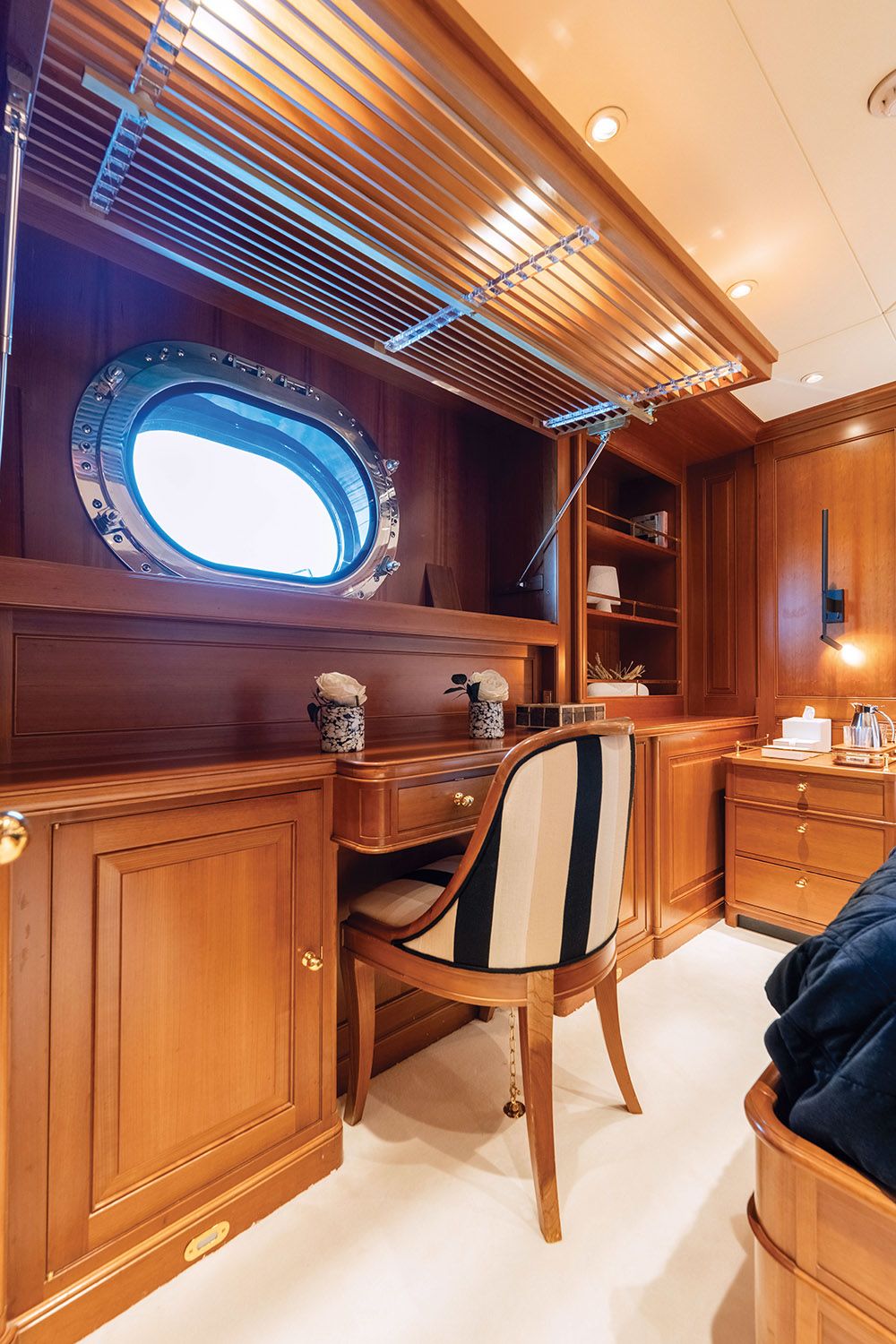
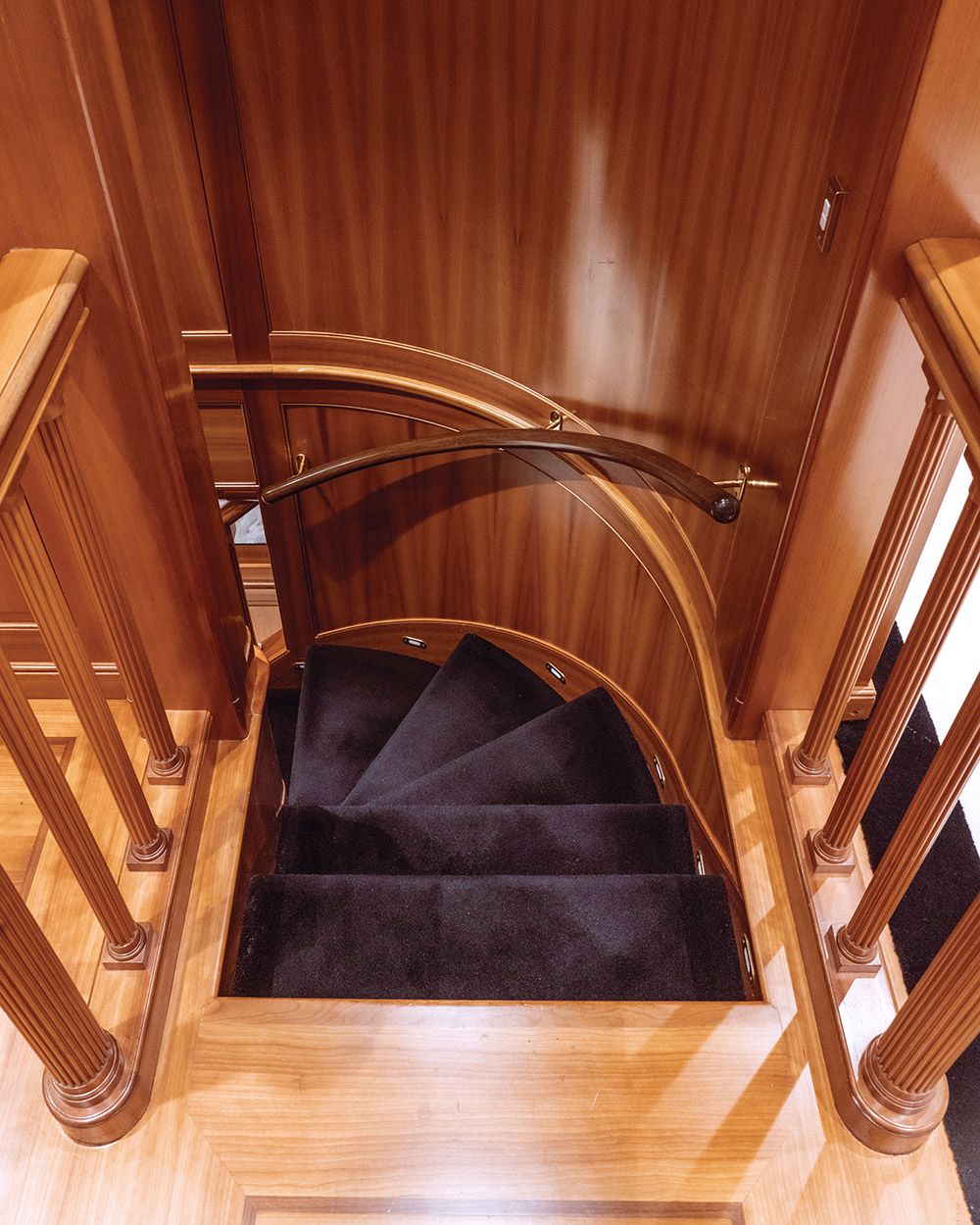
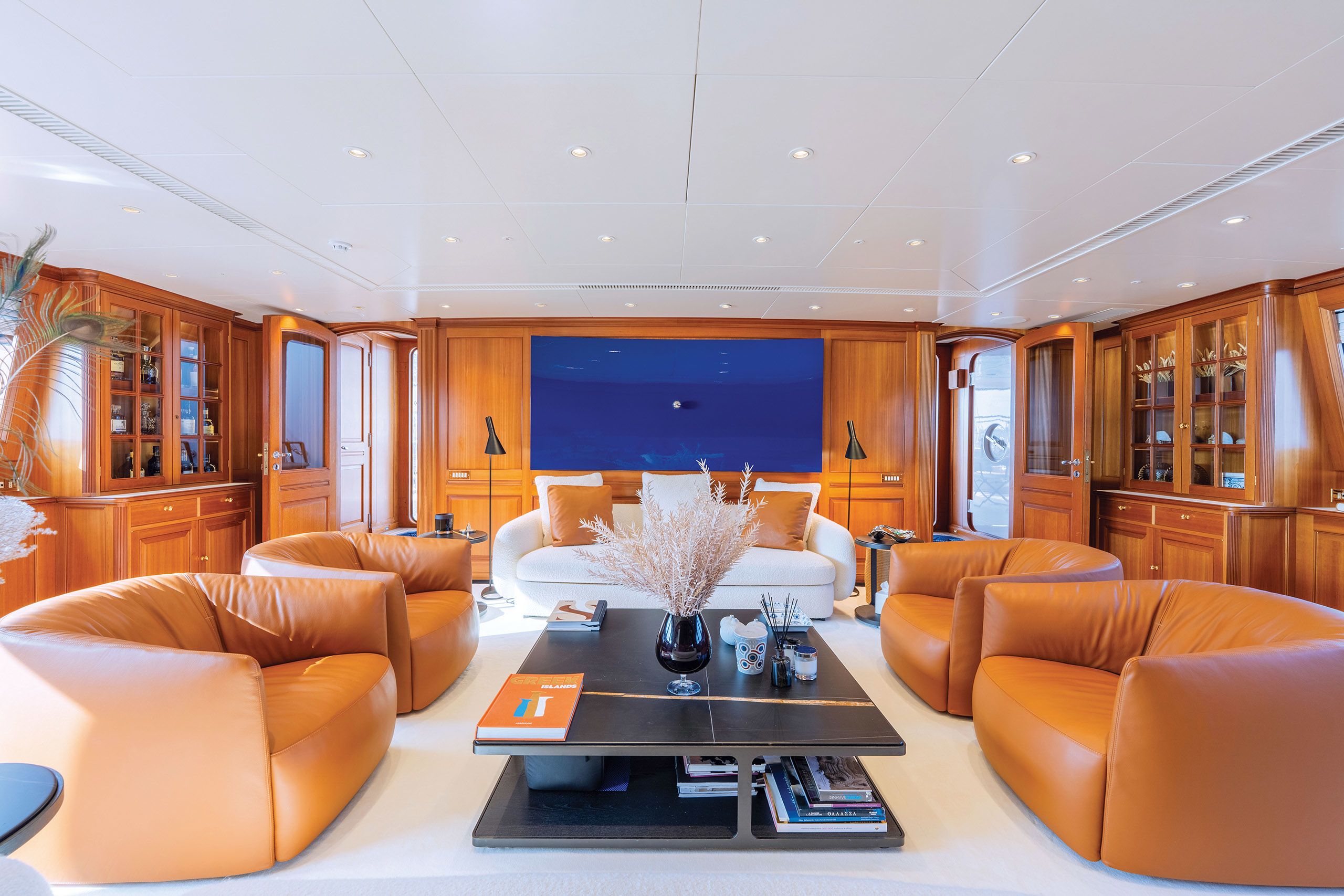
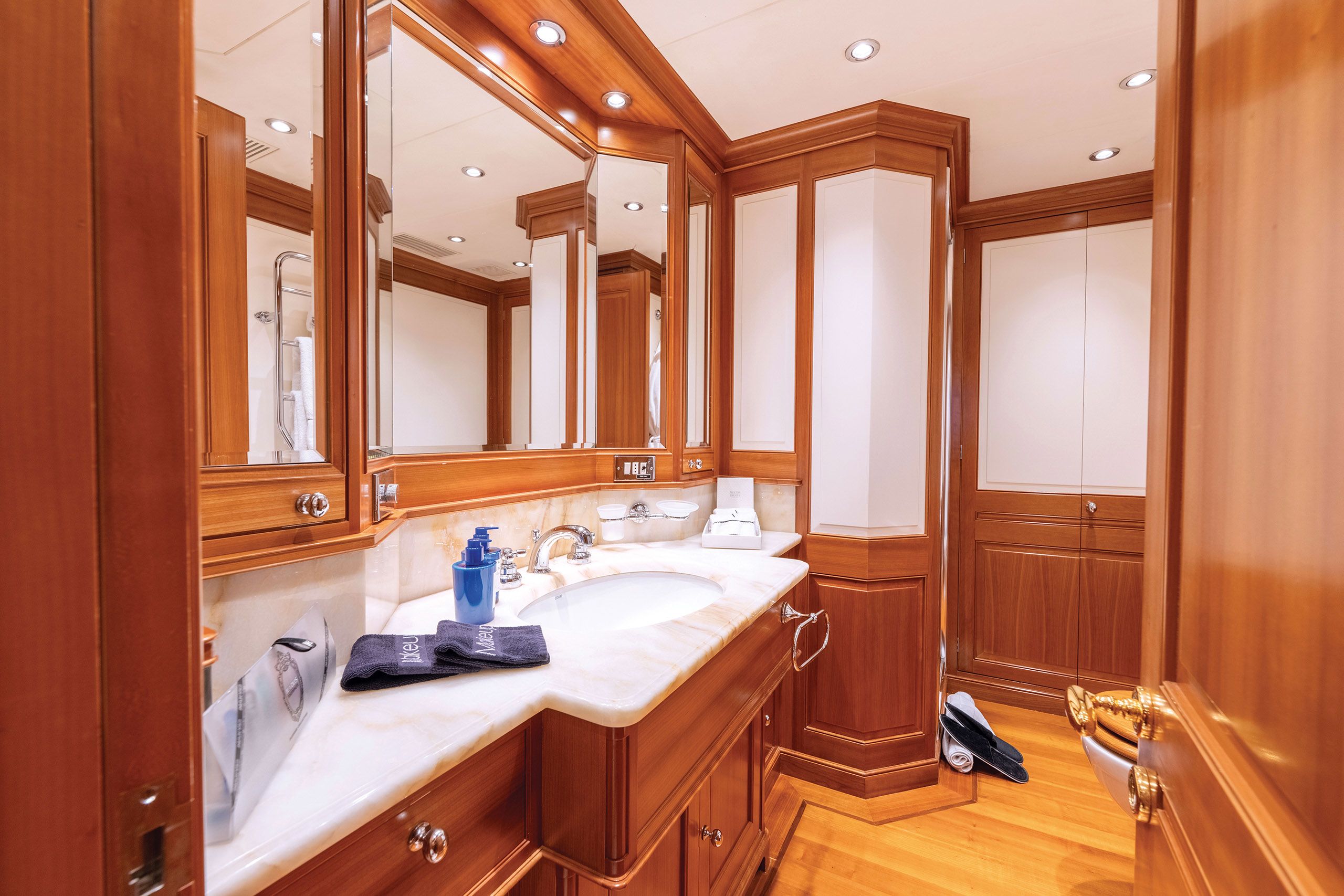

IYC
IYC

IYC
IYC

IYC
IYC

IYC
IYC

IYC
IYC
It was important to the owners to maintain elements of the original Perini Navi style. The cherry woodwork was restored and more than 3,000 drawer pulls were removed and refinished
Rigas liked the nautical feel of the formal dining room. The original dining chairs, which were reupholstered, have gold chains at the bottom so they can be affixed while under way. “Now that I’ve done two Atlantic crossings with her and raced the Bucket [Regatta] in St Barths, I understand how important it is to sail a solid boat that can combine a safe crossing and at the same time offer luxury living and competitive sail performance,” says Rigas. “Almyra II combines very elegantly all of the above. We sailed with a 25-degree heeling angle – I cannot stress enough that everything has to be battened down,” she says.
Rigas’s inspiration for the interior aesthetic was Hermès meets Ralph Lauren. “Not the Ralph Lauren florals, but the use of leather and the colour palette of brown, white and black,” she says. The limited-edition Christian Dior plates chosen for dining feature a compass rose as another nautical touch. Many of the furnishings are finished in white and tan, including the tan Poliform chairs and white sofas in the main saloon, adorned with Hermès throw pillows. “It was important that everything be comfortable and not stiff, so you can put your legs up and feel at home,” she adds. The coffee and side tables in the main saloon are made of Sahara Noir marble, which was used in the bar as well.
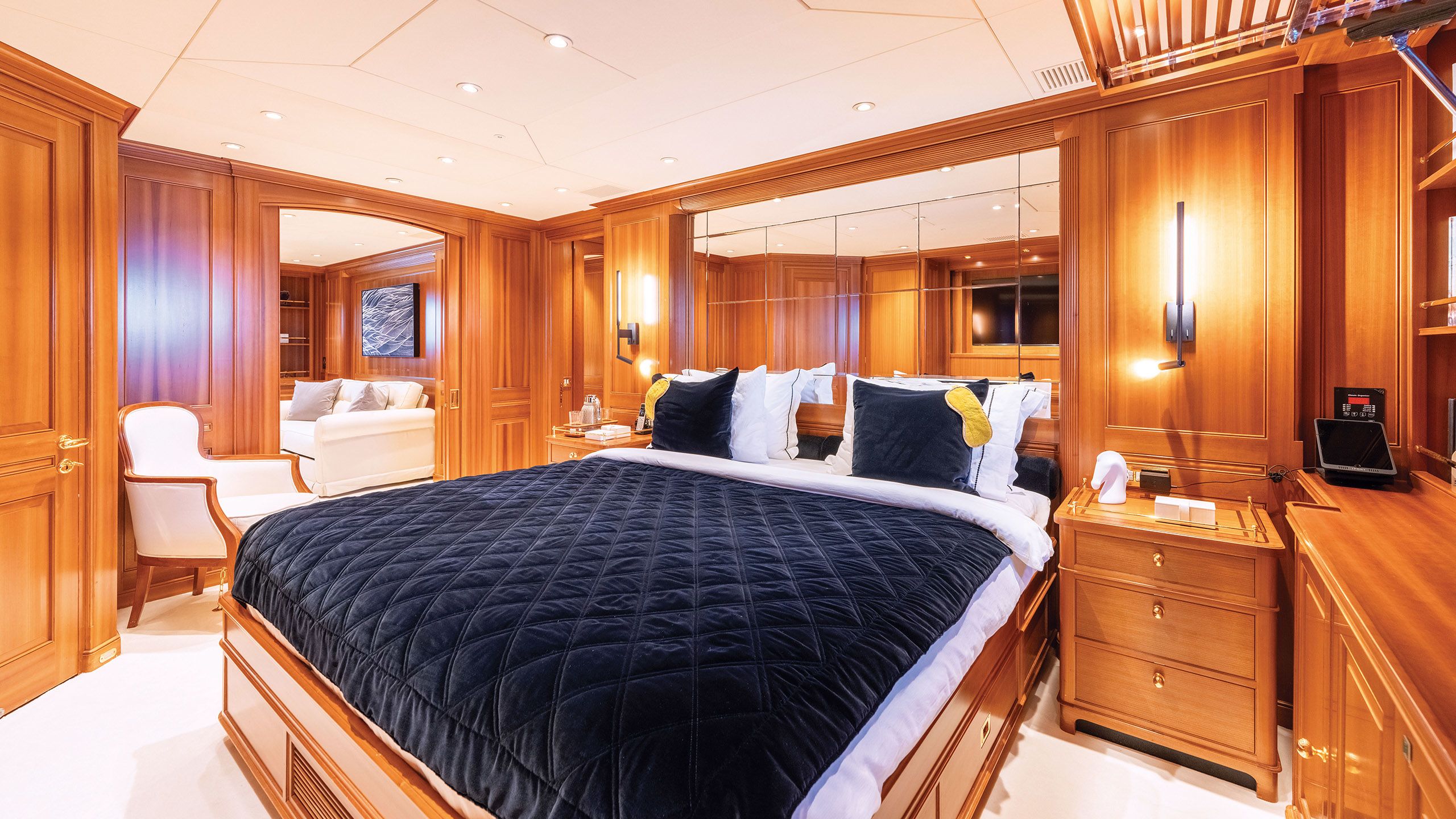
IYC
IYC
One thing that certainly didn’t change was the bar. “Everyone says Almyra II’s bar reminds them of the bar on Onassis’s Christina O in terms of the shape. I didn’t change it because it is a very elegant and classy shape,” says Rigas.
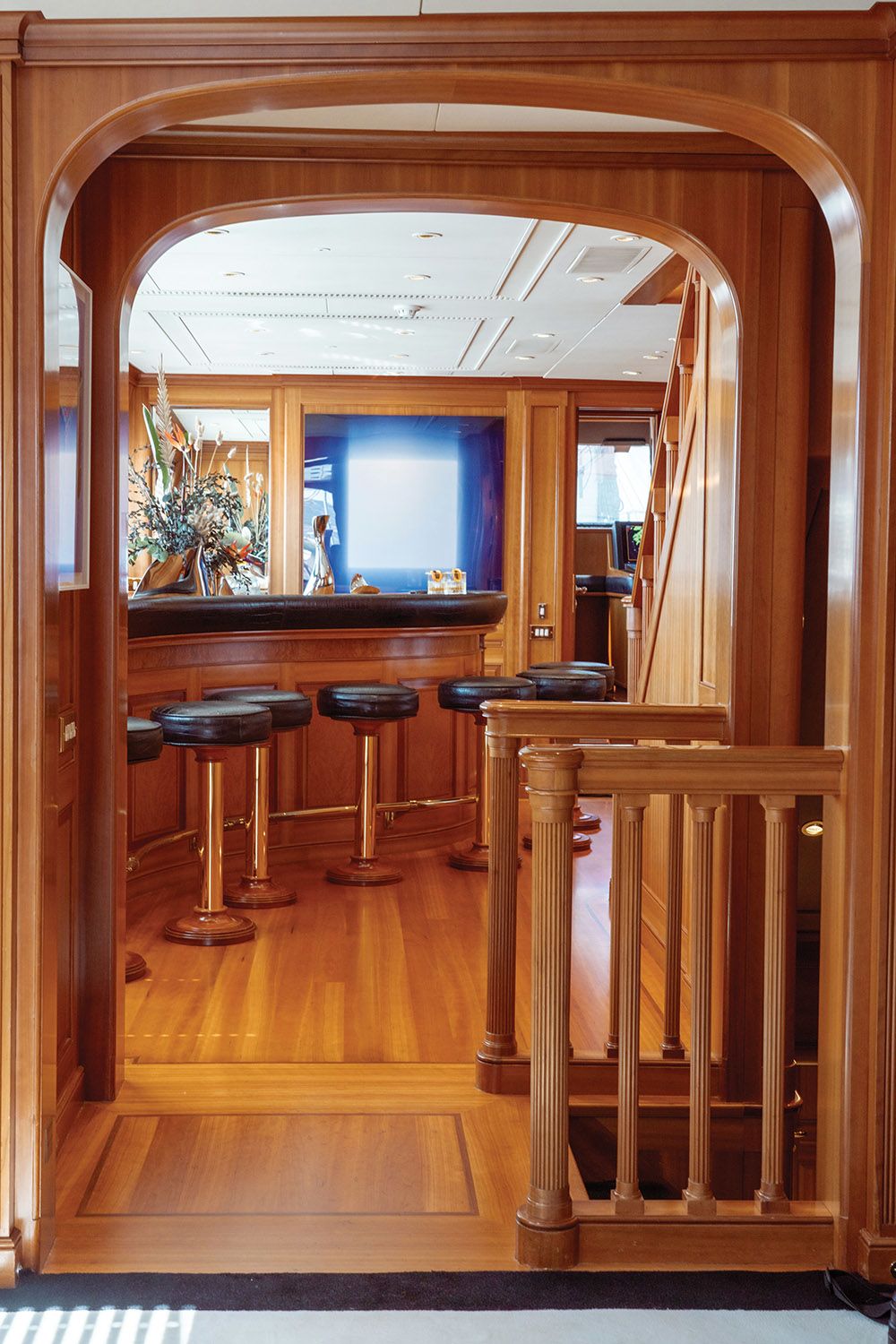
IYCOne area on board that didn’t change is the bar, which guests on Almyra II say reminds them of the famous bar on the classic yacht Christina O
IYCOne area on board that didn’t change is the bar, which guests on Almyra II say reminds them of the famous bar on the classic yacht Christina O
An extra-special piece of furniture is found on the exterior deck in the form of a fighting chair, a rather unusual sight to be found on a sailing yacht. Rigas says it was part of her husband’s wish list, as he does a lot of fishing. Even when not used for fishing, it’s a place to sit and look out at the ocean. Previously on the main deck aft, there was a fixed sofa, which has been replaced with a relaxed sofa and chairs that turn, while the custom-designed al fresco dining table has director-style chairs.
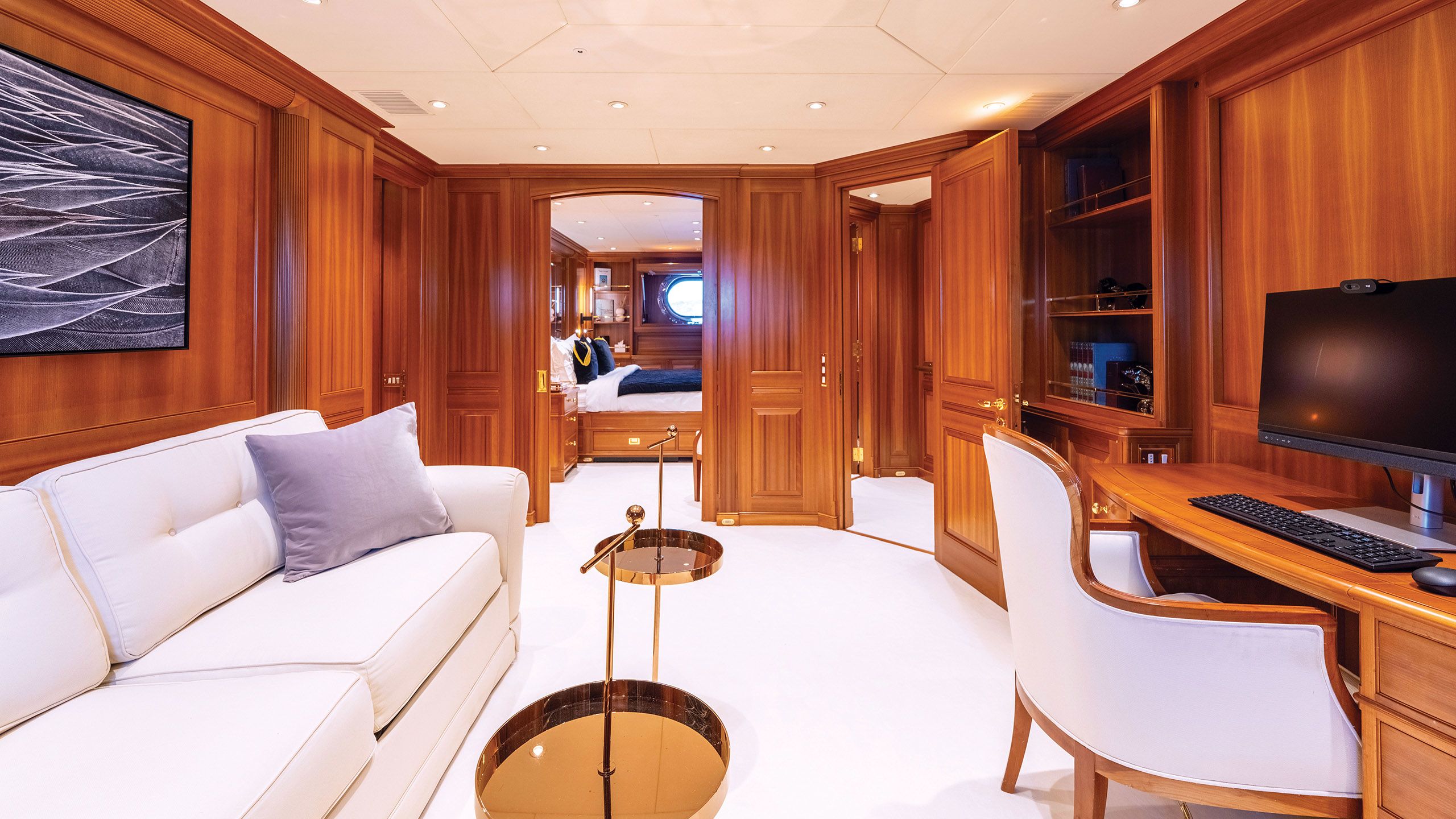
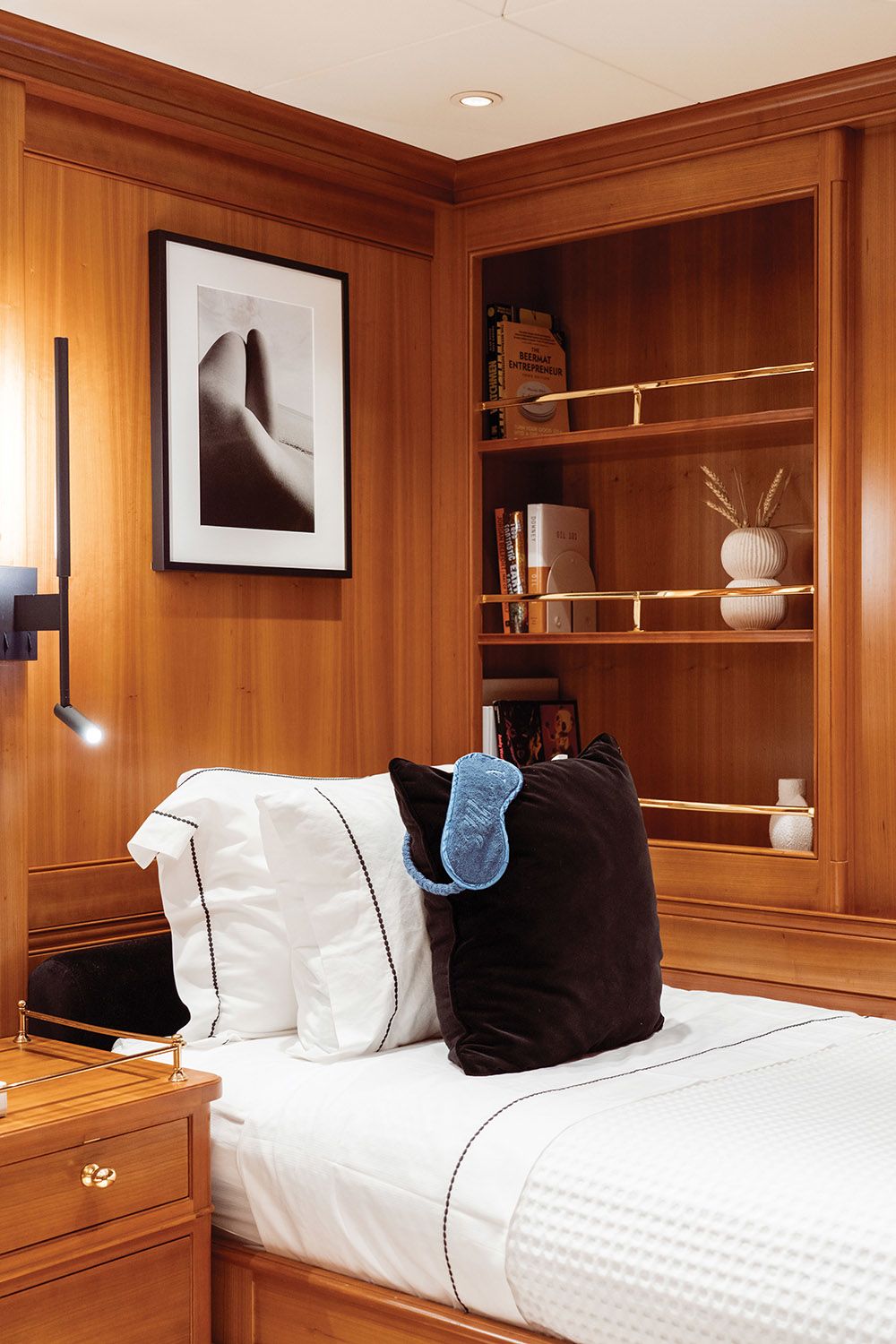

IYC
IYC

IYC
IYC
The aft owners’ suite is connected to an office and lounge area, which also can be used as a guest cabin
Another important part of the brief was the yacht’s environmental impact. “We wanted to co-operate with scientists as part of an ESG [environmental, social and governance] and sustainability programme,” says Rigas, who heads up the sustainability department for an energy company. “We wanted to make the yacht a suitable space to work with organisations such as Yachts for Science. Almyra II should be a place where owners, guests, crew and scientists can coexist and utilise our Perini Navi.” Rigas has also worked to make Almyra II as green as possible, from minimising the use of plastics and using refillable toiletries, to selecting environmentally friendly water toys.
THE ART OF SAILING
A dive into the details of Almyra II
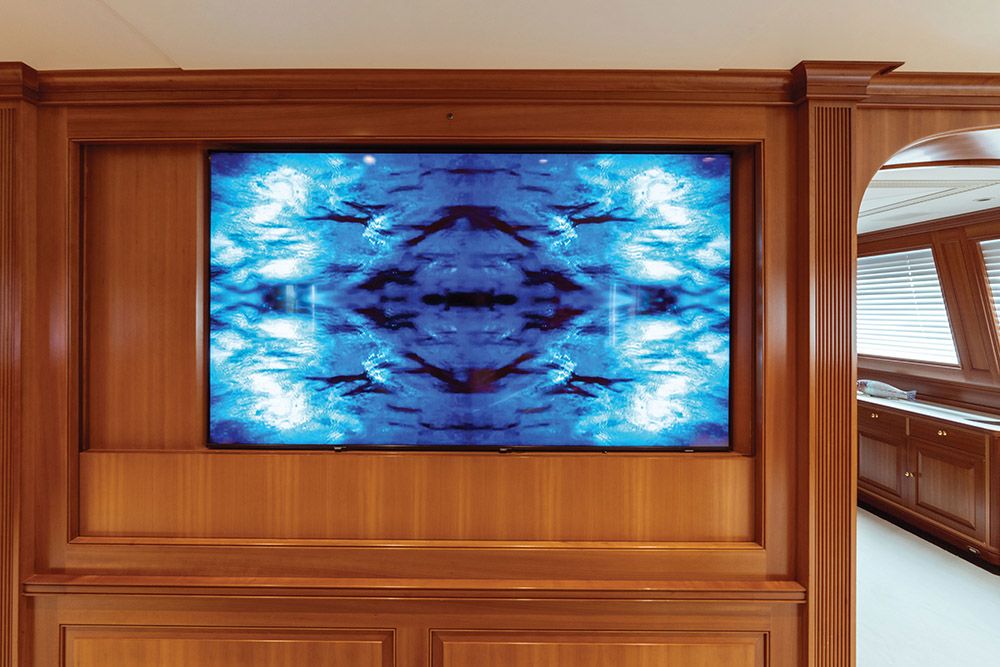
IYC
IYC
The thought of Almyra II cutting through the ocean, her wake washing up on the world’s landmasses, was the motivating force behind the works that Greek artist Danae Stratou produced for the yacht, both on deck and inside. The perspective she chose for the work on deck, Almyra Blue, was that of an albatross flying directly above Almyra II, catching a glimpse of how its curved, metal shape carves its way through the water. Works displayed in the interior expand on that overhead perspective. Inspired by her large-scale installation, Icesongs, two works adorning the interior, together with Ice Squared, are based on a satellite snapshot of a patch of ice on the Antarctic below.
The video art, displayed on the ship’s TV screens, offers variations on the Icesongs theme as well as a video of a more recent installation, Concentric, where the main element, a lake, generates concentric waves that Stratou imagines extend, in a healing manner, across the planet.
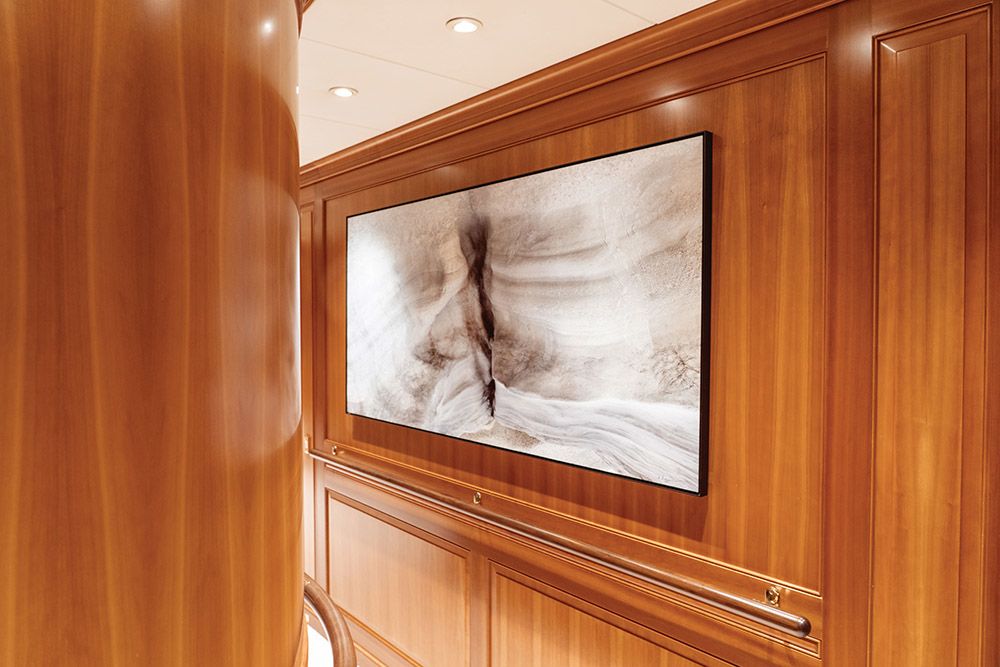
IYC
IYC
Lastly, the main wall-mounted sculpture work, Suspended Blue – Curved, combines a curved plane harking back to an earlier Stratou sculpture where the curvature captured her sense of “rising above the plane”, with a steel sphere suspended over a deep blue – a metaphor for Almyra II’s balancing act over the forces of nature.
Later in the refit, the hull was sandblasted and received a full Awlgrip paint job, along with the masts and superstructure. “The summer 2021 heatwave gave us some problems when it came to finishing the paint,” says Rigas. “We had to repaint her three times to get the finish, the gloss and the top quality that we were seeking from every subcontractor. “I have to admit, all of them bought into our vision and co-operated to end up with an excellent result that makes the boat look like new,” she continues. “There were frustrations like this throughout, but it’s a bit like giving birth – you forget all the frustrations and remember the good parts afterwards.”
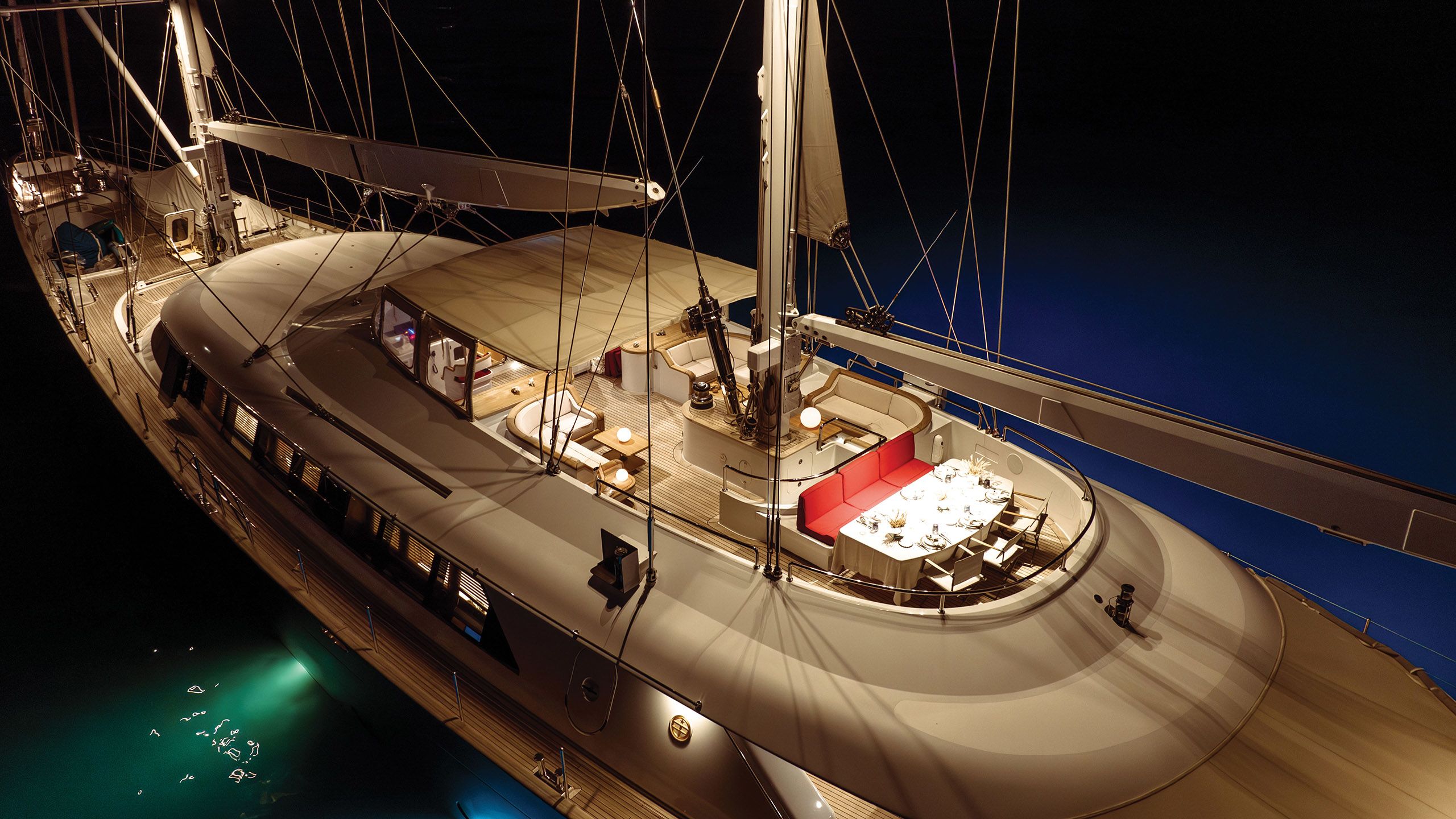
IYC
IYC
In addition to the challenges of a refit, the project had to contend with supply-chain delays from Covid-19. Yet the refit was still carried out in a swift manner. “She was completed in just nine months after hauling her out and 10 months after her arrival at the shipyard,” says Katsoulis. When I spoke to Rigas, she and her husband had just returned from crossing the Atlantic and travelling for six months on board. The next stage of their trip will take them further afield to the Pacific Ocean and beyond. “I found the boat felt really safe during crossings,” says Rigas, who would like to encourage other yacht owners to stay on board during ocean passages (see The unexpected joys of sailing across the Atlantic).
“I’d tell them, go and do it yourself. It was so nice to be away from technology, switch off from work and connect to your thoughts.” The longer circumnavigation is still in the works, and dreaming about it is what kept Rigas motivated during the refit of Almyra II. As she says: “It’s our dreams [that] keep us alive.”
First published in the November 2023 issue of BOAT International. Get this magazine sent straight to your door, or subscribe and never miss an issue.
A new dining area allows for evening meals under the stars
The tenders were upgraded to provide safety and watersports capabilities
The guest spaces remain the same post refit, yet the furnishings and their arrangement were updated
The aft deck boasts a fighting chair for reeling in fresh catch
The engines and generator were rebuilt with strict specs for emission monitoring and reduction
The owners’ sitting room converts to an additional guest cabin
LOA 50m | Gross tonnage |
LWL 44m | Engines |
Beam 10.27m | Generators |
Draught (kneel up/down) | Speed (max/cruise) |
Total sail area | Owners/guests 12 |
Sails Fuel capacity | Crew 9
|
Freshwater capacity | Classification |
Naval architecture | Builder/year |
Exterior styling and interior design | Refit yard/year |
Refit interior design | For charter |

